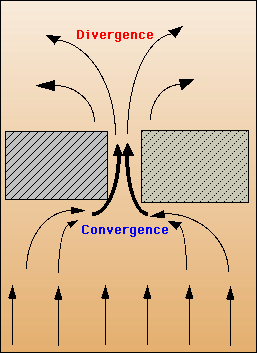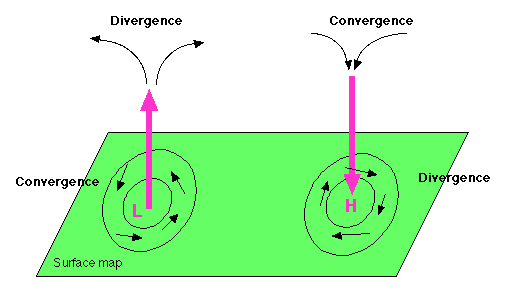| |
|
Convergence and Divergence
 We have mentioned that air spirals into low pressure centers due to the earth's spin. But where does the air go then? It cannot go into the ground, and so must compress and move upwards rapidly. The zone where the air meets is known as a convergence zone. Convergence can happen in the horizontal direction as well. Imagine two buildings beside each other as in the figure. Wind blowing against them will converge and go through the space that separates them, moving faster than the original flow because it is compressed. This is also called channeling. The opposite of convergence is divergence -- when air spreads out and slows down because of decompression. Air converges at the surface in low pressure systems and diverges aloft. The opposite takes place in high pressure systems. Convergence and divergence always produce vertical air motion.
We have mentioned that air spirals into low pressure centers due to the earth's spin. But where does the air go then? It cannot go into the ground, and so must compress and move upwards rapidly. The zone where the air meets is known as a convergence zone. Convergence can happen in the horizontal direction as well. Imagine two buildings beside each other as in the figure. Wind blowing against them will converge and go through the space that separates them, moving faster than the original flow because it is compressed. This is also called channeling. The opposite of convergence is divergence -- when air spreads out and slows down because of decompression. Air converges at the surface in low pressure systems and diverges aloft. The opposite takes place in high pressure systems. Convergence and divergence always produce vertical air motion.
The graphic below shows another view of convergence and diverges. This is an image of a surface map, showing both a low pressure system and a high pressure system. In the low pressure system, the air moves inward in a counterclockwise motion. This air must go somewhere, so it rises. Above the low pressure system (roughly 6 km above the surface), the air divergences.
Just the opposite happens over a surface high pressure system. Air moving away from the center of the high is replaced by air falling into the center. Convergence and divergence are important mechanisms for moving air vertically. 
Confused? Have a question? If so, check out the Frequently Asked Questions (FAQ) page or send mail to the OS411 tutor (os411tutor@shodor.org) with your question!
Report technical/content problems here
|
|